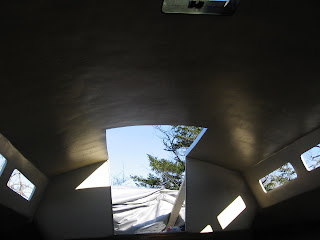Friday, February 27, 2009
Friday, May 2, 2008
Keel - Building out the leading edge and planing the trails edge
Tuesday, April 22, 2008
Templating the Keel
Had to grind down the cracked glass located where the keel attaches to the fibreglass stub on both the starboard and port sides. They were minor cracks but I couldn't live with them.

 Using the templates I have confirmed that this keel has not been templated with J/30 templates. The keel requires about 1/2 an inch (10MM) added to the leading edge. As you can see with the templates that creates a gap up into the maximum chord thickness.
Using the templates I have confirmed that this keel has not been templated with J/30 templates. The keel requires about 1/2 an inch (10MM) added to the leading edge. As you can see with the templates that creates a gap up into the maximum chord thickness.


 The end of the keel about 1 foot from the trailing edge wasn't flat so it had to be planned down.
The end of the keel about 1 foot from the trailing edge wasn't flat so it had to be planned down.
 I only had to plane down the trailing end of the keel (using a power planer). The leading edge was left untouched as it will be built up using hardwood battens about 10MM wide and 5MM thick.
I only had to plane down the trailing end of the keel (using a power planer). The leading edge was left untouched as it will be built up using hardwood battens about 10MM wide and 5MM thick.
 Same on the port side.
Same on the port side.

 Using the templates I have confirmed that this keel has not been templated with J/30 templates. The keel requires about 1/2 an inch (10MM) added to the leading edge. As you can see with the templates that creates a gap up into the maximum chord thickness.
Using the templates I have confirmed that this keel has not been templated with J/30 templates. The keel requires about 1/2 an inch (10MM) added to the leading edge. As you can see with the templates that creates a gap up into the maximum chord thickness.

 The end of the keel about 1 foot from the trailing edge wasn't flat so it had to be planned down.
The end of the keel about 1 foot from the trailing edge wasn't flat so it had to be planned down. I only had to plane down the trailing end of the keel (using a power planer). The leading edge was left untouched as it will be built up using hardwood battens about 10MM wide and 5MM thick.
I only had to plane down the trailing end of the keel (using a power planer). The leading edge was left untouched as it will be built up using hardwood battens about 10MM wide and 5MM thick. Same on the port side.
Same on the port side.Hull Update - All that is left is the polishing
Wednesday, April 9, 2008
Epoxy barriered holes for the deck hardware
All holes required to fasten down hardware was filled with epoxy before redrilling.
If leakage occurs in the future, the balsa core is not compromised and will stay dry. I predrilled the holes using variable speed with a 5/8" counter sink bit - then use a 5/8" inch forstner bit to drill the balsa out. Then filled the holes with epoxy thickened with collidical sillica, I used a 50 ML medical shringe to push the epoxy in. I used masking tape to seal off the inside so that the epoxy couldn't ooze out.


If leakage occurs in the future, the balsa core is not compromised and will stay dry. I predrilled the holes using variable speed with a 5/8" counter sink bit - then use a 5/8" inch forstner bit to drill the balsa out. Then filled the holes with epoxy thickened with collidical sillica, I used a 50 ML medical shringe to push the epoxy in. I used masking tape to seal off the inside so that the epoxy couldn't ooze out.


Hull Liner Primed and Painted
Subscribe to:
Posts (Atom)
















